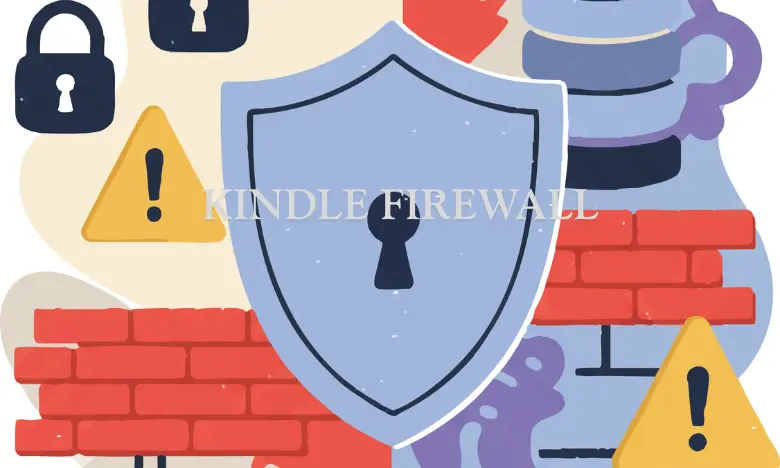Table of Contents
Introduction: Why Kindle Firewall Matters in 2025
In today’s connected world, digital privacy has become as essential as the device itself. If you own an Amazon Kindle Fire, you’ve probably used it for reading, streaming, or browsing. But did you know that your Kindle comes with a built-in Kindle Firewall that quietly guards your data and controls how your apps connect to the internet?
From blocking suspicious traffic to managing app permissions, the Kindle Firewall plays a vital role in ensuring safe browsing for adults and children alike. Yet, most users either overlook or misconfigure it. This guide explains how it works, why it matters, and how you can leverage it for maximum privacy and network security in 2025.
What Is Kindle Firewall and How It Protects Fire OS Users
At its core, the Kindle Firewall acts as a digital barrier between your Fire OS device and the internet. It monitors incoming and outgoing connections, blocks unauthorized access, and helps you control which apps can send or receive data.
Think of it as a smart gatekeeper that decides what gets through your Wi-Fi network and what doesn’t. It’s especially useful for parents, professionals, and anyone using Kindle Fire for streaming, reading, or kids’ educational content.
The Kindle Firewall ensures that third-party apps can’t secretly collect or share your personal data. Combined with Amazon’s Privacy Settings and Parental Controls, it offers one of the most secure environments in the tablet ecosystem.
How to Access and Configure Kindle Firewall Settings
To adjust Kindle Firewall settings, follow these steps:
- Go to Settings → Device Options → Advanced Settings
- Tap Security & Privacy
- Find Firewall Settings and enable or customize it
- You can restrict access for specific apps, IP addresses, or even Wi-Fi networks
- Restart your Kindle to apply changes
💡 Pro Tip: Combine your Kindle Firewall setup with VPN software like NordVPN or ExpressVPN for enhanced protection against data leaks and network intrusions.
Understanding Fire OS Firewall Components
The Kindle Firewall operates through three main layers within Fire OS:
| Component | Function | Security Level |
|---|---|---|
| Network Access Manager | Controls Wi-Fi and app data permissions | High |
| System Protection Layer | Monitors traffic for suspicious activity | Medium |
| User Firewall Settings | Allows manual blocking and app control | Customizable |
These layers make the Kindle Firewall highly adaptable — ideal for both personal and family devices. Each user profile can have its own configuration, allowing parents to limit online exposure for children while maintaining flexibility for adult users.
Parental Controls and Internet Filtering on Kindle Fire
One of the most powerful integrations of the Kindle Firewall lies in its connection with Parental Controls. When you enable these controls, the firewall automatically filters unsafe content, blocks adult websites, and prevents unauthorized downloads from the Amazon Appstore.
🔒 Benefits:
- Restricts harmful websites through Internet Filtering
- Limits app installations via App Permissions
- Ensures safe streaming on Amazon Prime Video and YouTube Kids
- Enhances Digital Wellbeing by managing screen time
Parents can even set different rules for each user profile, ensuring younger users only access educational or age-appropriate content.
Kindle Firewall vs VPN vs Third-Party Security Tools
Let’s compare the Kindle Firewall with popular security solutions:
| Feature | Kindle Firewall | VPN | Third-Party Security Apps |
|---|---|---|---|
| Network Blocking | ✅ Yes | ✅ Yes | ✅ Yes |
| App Control | ✅ Yes | ❌ No | ✅ Partial |
| Malware Defense | ⚠️ Limited | ✅ Strong | ✅ Strong |
| Data Encryption | ❌ No | ✅ Yes | ✅ Yes |
| Parental Control | ✅ Integrated | ❌ No | ✅ Optional |
As seen above, Kindle Firewall focuses more on app-level network control, whereas a VPN protects your overall data transmission. Using both together can create a strong, multi-layered security setup — essential for privacy-conscious Kindle users.
Managing App Permissions Through Amazon Account
Your Amazon Account is deeply linked to the Kindle Firewall system. Each app you install through the Amazon Appstore requests certain permissions. You can manage these directly from your Kindle’s App Permissions menu.
If an app tries to connect to an unapproved Wi-Fi network or sends data in the background, the Kindle Firewall can block it automatically. This integration helps prevent malware or phishing attempts that often exploit open connections.
Enhancing Privacy Settings and Data Protection
The Kindle Firewall works in harmony with Privacy Settings under Fire OS. By adjusting them together, you create a balanced privacy ecosystem.
Here’s how to strengthen it:
- Disable ad tracking under Settings → Privacy → Advertising ID
- Limit app permissions for location and microphone access
- Use VPN tunneling for encrypted connections
- Regularly check System Updates to patch vulnerabilities
When configured correctly, the Kindle Firewall serves as the first defense layer against malicious data interception or unauthorized app communication.
Advanced Kindle Firewall Techniques for Power Users
If you’re a tech-savvy Kindle user or a cybersecurity enthusiast, consider going beyond default configurations:
- Custom Port Blocking: Prevent apps from accessing risky ports commonly used by trackers.
- AI-based Content Filtering: Integrate with third-party AI parental tools for advanced filtering.
- Zero Trust Network Setup: Treat every connection as untrusted until verified.
- Smart Home Integration: Secure communication between Kindle Fire and Alexa or Echo devices through firewall rules.
Such advanced configurations make the Firewall comparable to professional-grade security systems.
Troubleshooting Kindle Firewall Issues
Sometimes, misconfigured settings can block essential services like the Amazon Appstore or Silk Browser. Common issues include:
- Appstore not loading
- Alexa unable to connect
- Streaming apps blocked
- VPN disconnections
🔧 Fix:
- Temporarily disable Kindle Firewall
- Reconnect your Wi-Fi network
- Check Fire OS version updates
- Whitelist key Amazon services
- Re-enable the firewall with adjusted rules
Keeping firmware updated and avoiding over-restrictive rules will ensure smooth device performance.
Case Study: Kindle Firewall for Family Use
A real-world example illustrates its impact:
A parent noticed their child using a Kindle Fire for unrestricted browsing via the Silk Browser. After enabling the Firewall and customizing Parental Controls, the tablet became a safe zone — educational apps stayed accessible while harmful content was blocked.
This simple adjustment transformed an entertainment device into a secure educational platform — showing how practical and powerful Kindle’s built-in firewall truly is.

Kindle Firewall Pros and Cons
| Pros | Cons |
|---|---|
| Enhances online privacy | Limited malware detection |
| Built into Fire OS | Manual setup required |
| Great for parental use | No full data encryption |
| Customizable for each profile | Occasional app blocking issues |
| Integrates with Alexa ecosystem | Advanced features hidden from basic users |
Despite minor limitations, the Kindle Firewall is a strong first layer of protection — lightweight, built-in, and free.
Competitive Analysis: Why Kindle Firewall Beats Others
Competitors like Norton Mobile Security, Bitdefender, or Avast offer broader protection but lack native integration with Fire OS. The Kindle Firewall is unique because it’s tailored to the Amazon ecosystem — perfectly syncing with Fire OS, Amazon Appstore, and Parental Controls.
By combining it with VPN tools, regular System Updates, and good Privacy Practices, users can achieve a secure environment rivaling even premium Android security setups.
Kindle Firewall and Smart Home Security
As Amazon integrates its ecosystem — Alexa, Echo Dot, and Fire TV — the Firewall plays a crucial role in maintaining security consistency. It ensures your Kindle doesn’t become a weak link in your smart home setup.
Example: You can block Kindle from connecting to external IoT devices through customized firewall rules, reducing cross-device vulnerabilities.
Conclusion: Stay Protected with Kindle Firewall
In 2025, digital threats are evolving faster than ever. From data mining to spyware, no device is entirely safe — unless it’s properly configured. The Kindle Firewall is your silent shield, built directly into Fire OS, designed to safeguard your browsing, apps, and Wi-Fi connectivity.
Whether you’re a parent setting up a child’s tablet or a tech enthusiast optimizing for maximum privacy, mastering the Firewall is no longer optional — it’s essential. Combine it with VPN protection, smart Privacy Settings, and regular Fire OS updates, and your Kindle will stay safe, fast, and private for years to come.
Quick Setup Checklist
✅ Enable Kindle Firewall under Security & Privacy
✅ Adjust rules for Appstore, Silk Browser, and Alexa
✅ Turn on Parental Controls for child profiles
✅ Use a VPN for extra data encryption
✅ Keep Fire OS updated regularly
Final Thoughts
The Kindle Firewall may not be flashy, but it’s one of the most underrated security features on any tablet. Once you understand how to use it properly, you’ll realize that your Kindle Fire is not just a reading device — it’s a fortress.
FAQs About Kindle Firewall
Q1: What does the Kindle Firewall do on Amazon Fire tablets?
It monitors and blocks unauthorized network connections, keeping your data and apps safe.
Q2: How to enable Kindle Firewall on Fire OS 8 or newer?
Go to Settings → Security & Privacy → Firewall Settings, then turn it on.
Q3: Does Kindle Firewall block VPN connections?
No, it allows most VPNs. In fact, combining a VPN with Kindle Firewall enhances protection.
Q4: Can parental controls override Kindle Firewall rules?
Yes, Parental Controls have higher priority and can modify some firewall filters.
Q5: How to fix Kindle Firewall blocking Amazon Appstore downloads?
Whitelist the Appstore under Firewall Settings or reset the rules to default.

